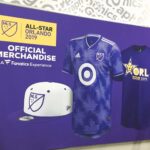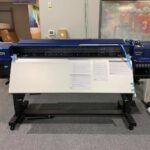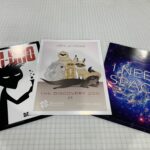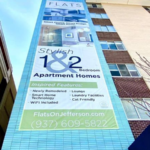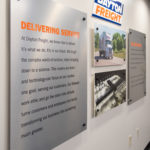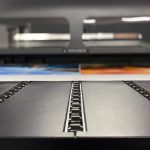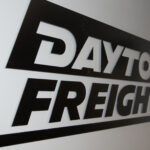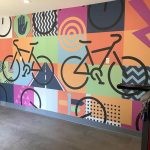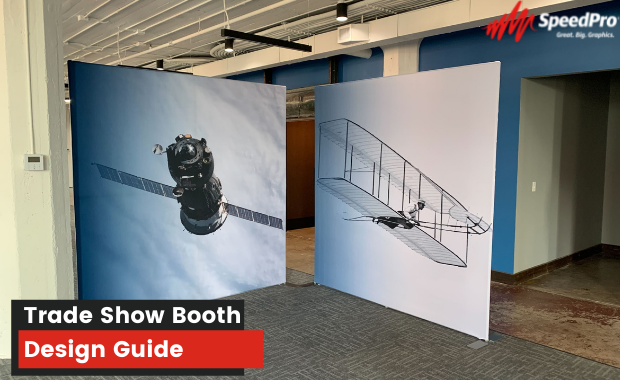
Trade Show Booth Design Guide
DECEMBER 27, 2021|When you participate in a trade show, your company is up against numerous other companies, all vying for the attention of visitors with their trade show exhibits. To differentiate yourself, you’ll need to understand your options for trade show exhibit booths, along with the ways you can take your booth to the next level.
To help you as you prepare for your next trade show, read for information about the different exhibit materials available and tips for creating compelling exhibits.
CATEGORIES FOR TRADE SHOW BOOTH PRODUCTS
To understand how to put together your trade show exhibit booth, you should be knowledgeable about all of the products and features available to you. When you’re well-informed on the materials you can use, you’ll be able to develop a custom trade show exhibit that’s sure to impress. Consider the following features of an effective trade show exhibit:
1. TABLE AND SURFACE GRAPHICS
Table graphics come in a variety of types and styles, including table runners, table skirts, miniature pop-ups, touchscreen mounts, tabletop signs and literature racks.
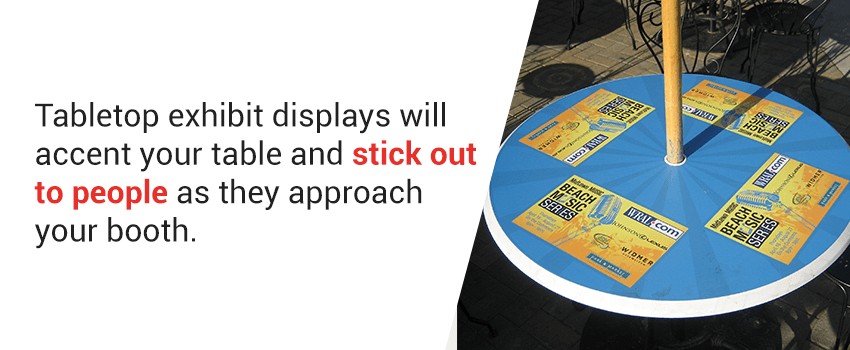
Table runners are one of the most popular options for trade show exhibits, as they can dress up your tables and make them more visually appealing. Dye-sublimated printed table runners and covers provide additional branding and messaging opportunities.
2. FLOOR GRAPHICS
Floor graphics are perfect for trade shows, as they can easily be applied and removed. They are designed with adhesives that make them easy to adjust or remove but still keep them securely attached to the ground even with a significant amount of foot traffic.
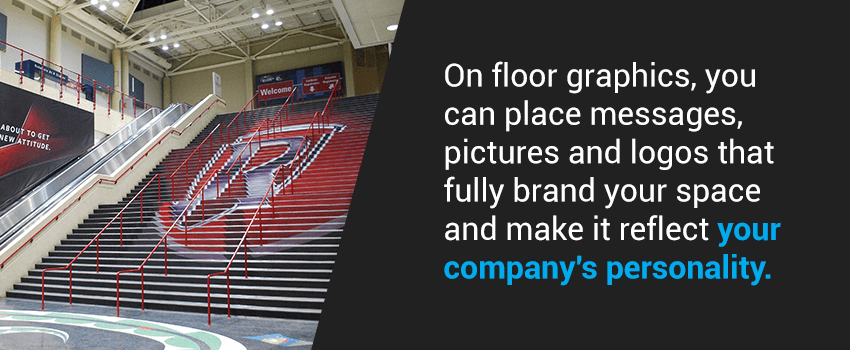
Along with branding your space, you can use floor graphics to direct people to your booth. While visitors might be overwhelmed with the number of booths and different companies vying for their attention, a carefully placed floor graphic can pull them back to the present moment, catching them off guard and getting them to notice your booth.
3. BOOTH BACKDROPS
Booth backdrops are central to any trade show exhibit display. They set the background of your display, giving your booth depth while also branding the exhibit. Some backdrop styles that you can include are half walls, hanging banners and paneled backwall accents. Adding custom imagery and designs to your backdrops can help establish the theme of your booth and help you promote your brand.
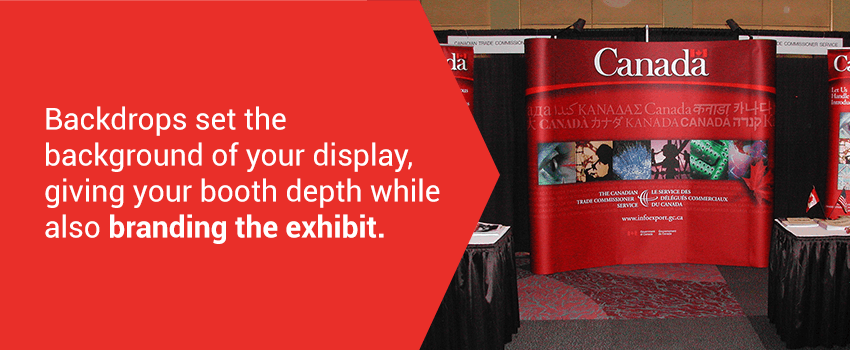
Along with providing full backgrounds that cover the back of the entirety of your booth, you can also use backwall accents to add an extra flair to your booth’s backdrops and walls. For example, backwall ladder accents are visually appealing and can serve as shelving for your latest products or company literature. With backwall connectors, you’ll be able to attach two different walls to create a larger backwall.
4. WALL GRAPHICS
As their name suggests, wall graphics let you add signs and displays to your backwalls at trade shows. With wall graphics, you can add fabric poster displays, mounted banners and folding panel screens onto the walls and partitions of your booth.
The fabric poster displays are especially useful as they provide frames and beautiful canvasses for your graphics and images. With light-box technology, some of these displays will even have an LED diffuser panel to make sure that your graphics always receive proper light distribution and brightness. At a trade show, little touches like proper lighting on your graphics can make all the difference in an attendee noticing your message.
5. BOOTH FORMATIONS
With booth formations, you’ll be able to set the overall layout of your display design. Despite these formations covering a lot of ground, they are designed for portability and ease of assembly.
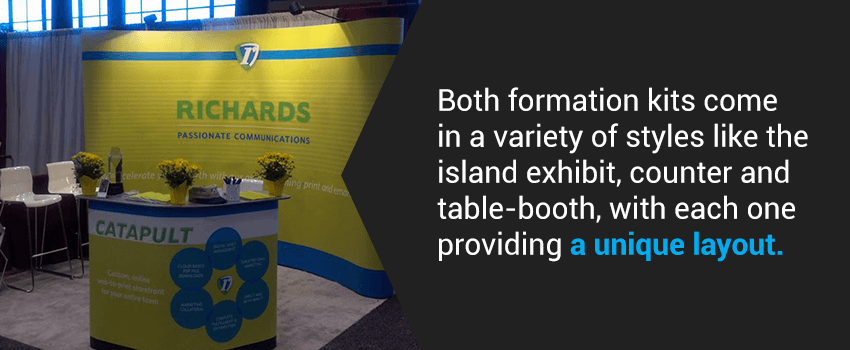
For island exhibits, in particular, you have a variety of options for the formation of your booth. The Orbital Express™ Truss comes with tall graphic panels, counters for displaying materials and a variety of configurations to attract visitors to your booth. Another option, the Hybrid Pro™ Modular exhibit, arrives with laminated panels, semi-private meeting areas, towers and much more for a unique design. Additionally, they come with accents like monitor mounts, display lighting and literature racks.
6. ADDITIONAL INSTALLATION FEATURES
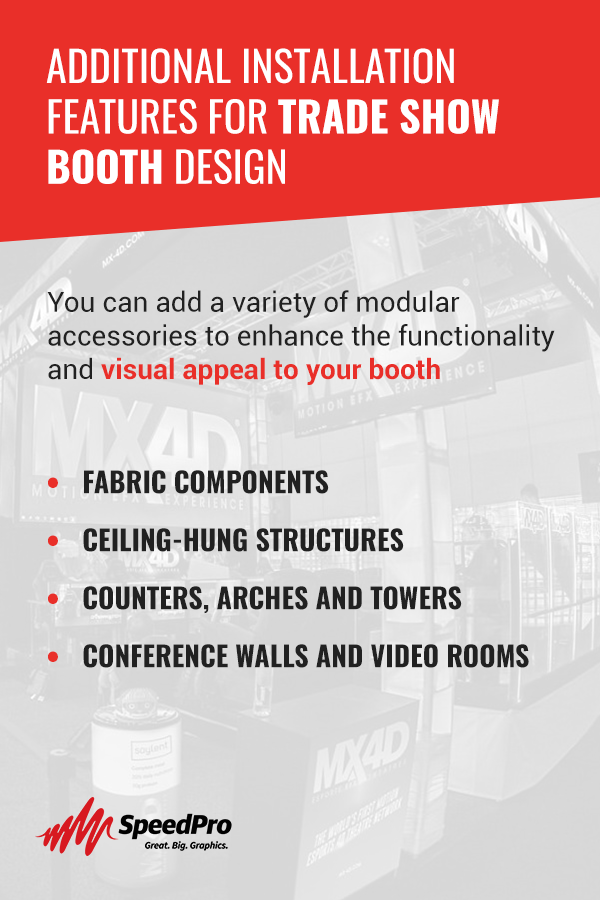
To enhance the functionality and visual appeal of your booth, you can add extra features such as architectural fabric components, ceiling-hung structures and walk-up counters. In addition to these features, you can add a variety of modular accessories to the displays.
Fabric-overlayed modular counters are stand-alone displays that add functional value and a unique look to your trade show exhibit. You can mix and match these counters with your other exhibit features. As they are fabric-overlayed, they can include custom graphics to improve the aesthetic of your booth. Along with modular counters, architectural fabric components make it possible to include unique conference walls, arches, towers, funnels and video rooms in your booth.
7. INTERACTIVE ELEMENTS
One way to increase visitor engagement is to use interactive installations at your booth to give visitors something to do. An interactive installation gives visitors a hands-on, immersive experience that keeps them at your exhibit longer, giving you more time to make a positive impression. Some useful interactive elements include touchscreens, televisions, computers, step and repeat banners, kiosks, computers, fabric iPad stands, digital signage and more.
One of the main features that you can include is fabric overlapped iPad Kiosks. Adding custom graphics to the structures for these kiosks can aid in your exhibition stall branding. You can then set up the iPads to engage users with a game, survey, video or other engaging feature. Another way to increase engagement and spread your brand is with step and repeat banners. Visitors can take a picture with your banner serving as a backdrop, increasing engagement with your brand.
TIPS FOR TRADE SHOW DESIGN
When you design your trade show exhibits, you’ll need to follow a few basic principles to make your exhibit booth both eye-catching and inviting.
- Stick to your brand’s identity: As you put together your exhibit, it’s best to represent your company in the most accurate way possible. Potential clients and customers will be able to sniff out dishonesty, and besides, as you try to generate brand awareness, you don’t want to confuse them with varying brand identities.
- Find the right location: Even if you have the perfect exhibit that captures your brand message perfectly, you can still fail to make an impression if your booth isn’t located in a place where people are likely to stop. For example, you’ll want to scout the trade-show floor to find a site that is going to be heavily trafficked. Typically, you’ll find heavy foot-traffic near entrances, stairs and elevators. Avoid setting up by columns or other structures that prevent people from noticing your booth.
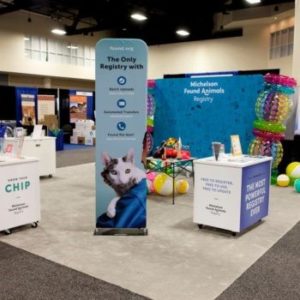
- Craft quality copy: For trade show booths, you need to use eye-catching copy that your audience can quickly understand. Generally, it’s best to use a tagline that’s about six words long that readers can instantly connect with. The copy should clearly state what your brand represents to connect you with customers who relate to the values and purpose of your brand.
- Figure out your purpose: What are your goals for the trade show? Do you want to make new contacts, find qualified leads, demo your latest products or do something else entirely? Understanding your purpose will help you as you decide how to design your trade show booth and choose what messages you’ll highlight. It’s important to remember that at a trade show, the main purpose is generally not to sell but to be helpful and provide visitors with information.
- Determine your main message: After you’ve determined your purpose, you’ll want to figure out what your main message is. When people leave the trade show, what do you want customers to remember about your booth? Once you know what the primary service, product or message you want to highlight for visitors is, you’ll want to promote it throughout your booth.
- Display the main message on the backwall: If you have a backwall on a small or mid-sized booth, you should place your message on it, as the backwall often acts as a focal point. Visitors’ eyes will be drawn to the backwall, and as such, graphics on it should be used to heighten the overall look of your booth while highlighting your main message.
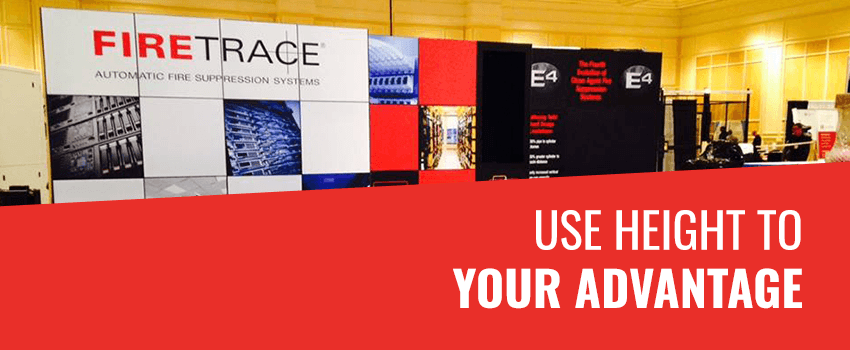
- Use height to your advantage: When you set up your booth, choosing towers or other tall graphics can make your company literally and figuratively stand out from the competition. These graphics can pull in visitors from a long distance and make it easier for people to find your booth.
- Avoid the overuse of static images: You want your graphics to stand out and pop. As such, you don’t want to saturate your exhibits with an overwhelming number of images. Instead of throwing tons of pictures at visitors, you’ll want to be selective about the ones that you choose to include. When people look at your booth, you’ll want to make a lasting impression on visitors with images that stand out.
- Don’t go overboard with colors: A good set of guidelines to follow when it comes to colors is to only include a maximum of three colors. Like your copy, you’ll want to keep your colors simple and to the point. The colors you choose to use should be on-brand, assisting in generating brand familiarity outside of the trade show’s walls.
- Keep text legible: Make sure that you’re using fonts that are easy to read and that the text is the appropriate size. In addition to choosing easy-to-read fonts, you should aim only to use two or three different fonts at your booth, if you use multiple fonts at all. Make sure your fonts are large enough that they’re easy to read from where attendees will be standing.
- Create private meeting areas: On a busy trade show floor, it pays to have space where you can meet with a potential customer privately. There are a variety of products that can help you wall off an area of your booth so that it becomes a private meeting or presentation area. These spaces can be particularly appealing for attendees who want to get away from the crowds for a little while.
- Don’t neglect lighting: One of the main reasons that companies come up short with their booths is forgetting to add custom lighting options. For example, backlighting on a large sign can make your company stand out even more and get more attendees to visit your booth. When you select trade show graphics, ask about how you should light them and implement that lighting at your next trade show.
DIFFERENCES BETWEEN SHORT-RANGE, MID-RANGE AND LONG-RANGE GRAPHICS
As you decide on what graphics should be included in your trade show exhibit display, you’ll need to know the difference between short-range, mid-range and long-range graphics. Where your trade show booth is located and where you expect visitors to first notice your exhibit will help determine the ideal type of graphic for your booth.
1. LONG-RANGE GRAPHICS
Long-range graphics are ideal for when you want people to be able to see your booth from far away. Since these graphics are meant to be seen from a distance, they should be placed as high as possible.
As you design these graphics, it’s important to remember that the main goal of a long-range graphic is to get people to notice your booth. The message should be simple, with the text as legible as possible. Lots of images and text make it hard for people to understand your message.
To make the graphic as noticeable and clear as possible, use high-contrast versions of your brand color scheme paired with a simple, legible font. Additionally, you’ll want to include either a recognizable slogan or image to help people recognize your brand.
If you’re at a trade show where visitors are unfamiliar with your brand, it’s better to use a slogan. A slogan is usually a stronger choice if you are an unknown company, as it can quickly communicate why people should visit your booth. In contrast, if you’re well known, a logo or piece of iconic imagery is a great choice, as people already know who you are.
Long-range graphics are often a smart choice, but companies should always consider whether they are appropriate for the venue. In some locations or with a particular audience, a towering graphic that stands over the other booths may be seen as too aggressive. You’ll need to do your best to assess the venue and potential audience before you decide to include a long-range graphic your exhibit.
2. MID-RANGE GRAPHICS
Mid-range graphics are crucial for any booth as they help attract attendees who are at other exhibits to come to yours. You can think of these graphics as the beginning of your sales pitch.
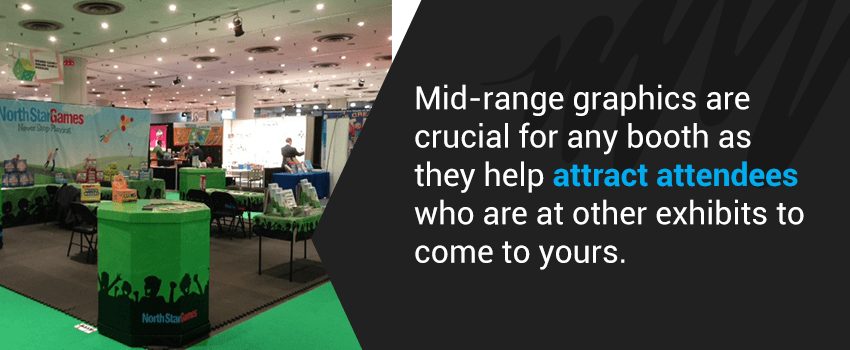
These graphics commonly advertise free samples, fun activities and other interactive elements of your presentation. Along with these overt advertisements of what your exhibit offers, these graphics often include images that appeal to your target demographic by addressing their pain points, interests and lifestyles.
As compared to the more basic designs of long-range graphics, mid-range graphics can be more complex. The primary purpose of your mid-range graphics is to leave viewers wanting to know more about your company. With their curiosity piqued, many attendees will then come to your booth to learn more.
3. SHORT-RANGE GRAPHICS
Short-range graphics are aimed at people who are already in your booth. Rather than getting their attention or piquing their curiosity, these graphics are about converting them. The form that your conversion takes can vary widely, depending on your goal, whether that’s selling a product, building qualified leads or finding quality new staff members.
In these graphics, you’ll often find unique products, company accomplishments and other important information highlighted. As people will be viewing them up close, short-range graphics can include intricate designs, details about your company and longform copy. In effect, you want to tell a story about your company or services that visitors can understand and feel connected to. Once the graphics hook them, one of your representatives can complete the conversion process.
Though you can have complex designs and longform messages, you still want to avoid overwhelming the reader. The last thing you want is for people to lose interest.

